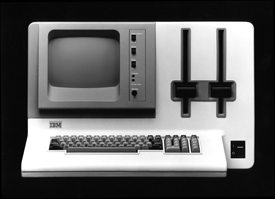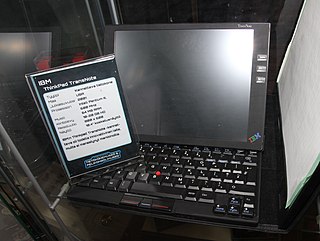
ThinkPad is a line of business-oriented laptop computers and tablets, the early models of which were designed, developed and marketed by International Business Machines (IBM) starting in 1992. In 2005 IBM sold its PC business, including laptops to Lenovo. The Chinese manufacturer further developed the line, and is still selling new models in 2024.
IDEO is a design and consulting firm with offices in the U.S., England, and China. It was founded in Palo Alto, California, in 1991. The company's 500 staff uses a design thinking approach to design products, services, environments, brands, and digital experiences.

The IBM PC Convertible is a laptop computer made by IBM, first sold in April 1986. The Convertible was IBM's first laptop-style computer, following the luggable IBM Portable, and introduced the 3½-inch floppy disk format to the IBM product line. Like modern laptops, it featured power management and the ability to run from batteries.

The IBM ThinkPad 701 is a subnotebook in the ThinkPad line by IBM. The 701 is colloquially known as the Butterfly due to its sliding keyboard, which was designed by John Karidis. It was developed from 1993 and sold from March 1995 until later that year and priced between $1,499 and $3,299. The 701 was the most sold laptop in 1995 and has received 27 design awards. It was based on either the DX2 or the DX4 version of the Intel i486, combined with CT-65545 graphics chip from Chips and Technologies. The 701Cs version used a DSTN display, while the 701C used a TFT LCD. It was pre-installed with Windows 3.11 and for the DX4 models also with OS/2 Warp 3.0. The 701 was discontinued because the keyboard design was no longer a necessity after screen sizes increased. After its discontinuation there has been some speculation about a new notebook with a butterfly style keyboard.

The IBM 5120 Computing System was announced in February 1980 as the desktop follow-on to the IBM 5110 Computing System. It featured two built-in 8-inch 1.2 MB floppy disk drives, 9-inch monochrome monitor, 32 KB RAM and optional IBM 5114 stand-alone diskette unit with two additional 8-inch 1.2 MB floppy disk drives. The system was sold with both APL and BASIC languages in ROM and provided a toggle switch on the front panel to select the language. APL allowed numerous business software written on IBM minicomputers to run on the 5120.

Lenovo Group Limited, trading as Lenovo, is a Chinese-American multinational technology company specializing in designing, manufacturing, and marketing consumer electronics, personal computers, software, business solutions, and related services. Products manufactured by the company include desktop computers, laptops, tablet computers, smartphones, workstations, servers, supercomputers, data storage devices, IT management software, and smart televisions. Its best-known brands include its ThinkPad business line of laptop computers, the IdeaPad, Yoga, LOQ, and Legion consumer lines of laptop computers, and the IdeaCentre, LOQ, Legion, and ThinkCentre lines of desktop computers. As of 2024, Lenovo is the world's largest personal computer vendor by unit sales.

Design management is a field of inquiry that uses design, strategy, project management and supply chain techniques to control a creative process, support a culture of creativity, and build a structure and organization for design. The objective of design management is to develop and maintain an efficient business environment in which an organization can achieve its strategic and mission goals through design. Design management is a comprehensive activity at all levels of business, from the discovery phase to the execution phase. "Simply put, design management is the business side of design. Design management encompasses the ongoing processes, business decisions, and strategies that enable innovation and create effectively-designed products, services, communications, environments, and brands that enhance our quality of life and provide organizational success." The discipline of design management overlaps with marketing management, operations management, and strategic management.

Subnotebook, also called ultraportable, superportable, or mini notebook, was a marketing term for laptop computers that are smaller and lighter than a typical notebook-sized laptop.
The Industrial Design Excellence Awards is a program sponsored by BusinessWeek and the Industrial Designers Society of America ("IDSA"). These are the awards which were given out for 2006.

Richard Sapper was a German industrial designer who was based in Milan for much of his career. He is considered to be one of the most influential figures of post-war Italian design. His products typically feature a combination of technical innovation, simplicity of form, and an element of wit and surprise. He received numerous awards and distinctions, including 11 Compasso d'Oro awards, the Raymond Loewy Foundation's Lucky Strike Designer Award, and the German Order of Merit. Examples of Sapper's work are held by museums such as the Victoria and Albert (V&A) and Design Museum in London, the Pompidou Center in Paris, the ADI Design Museum in Milan, and the Museum of Modern Art (MoMA) in New York, which counts over 17 of his designs in its collection.

Pen computing refers to any computer user-interface using a pen or stylus and tablet, over input devices such as a keyboard or a mouse.
Strategic design is the application of future-oriented design principles in order to increase an organization's innovative and competitive qualities. Its foundations lie in the analysis of external and internal trends and data, which enables design decisions to be made on the basis of facts rather than aesthetics or intuition. The discipline is mostly practiced by design agencies or by internal development departments.

Mark Dziersk was an American industrial designer based in Chicago, Illinois.
Michael McCoy is an American industrial designer and educator who has made significant contributions to American design and design education in the latter half of the 20th century. McCoy is best known as the co-chair of the graduate program in Design at Cranbrook Academy of Art where he and spouse Katherine McCoy pioneered semantic approaches to design.
The history of tablet computers and the associated special operating software is an example of pen computing technology, and thus the development of tablets has deep historical roots. The first patent for a system that recognized handwritten characters by analyzing the handwriting motion was granted in 1914. The first publicly demonstrated system using a tablet and handwriting recognition instead of a keyboard for working with a modern digital computer dates to 1956.

ELEVEN, LLC is a product development studio with offices in Boston, Massachusetts and New York City, New York. The studio was founded in 1996 by Ben Beck, Dave Harting, Doug Marsden and Glen Walter. Since then the company has designed products and experiences across multiple categories: from consumer goods and housewares, to electronics, medical machinery, sporting goods, and furniture.

The IBM ThinkPad 700 is the first notebook computer for the ThinkPad brand that was released by IBM on October 5, 1992. Another series was released alongside it, the ThinkPad 300 series. The 300 series was meant to be a cheaper, lower performance model line over the 700. It was developed as a successor to the L40SX.

The IBM ThinkPad TransNote is a notebook computer by IBM.
Samuel "Sam" Lucente is an industrial designer.













